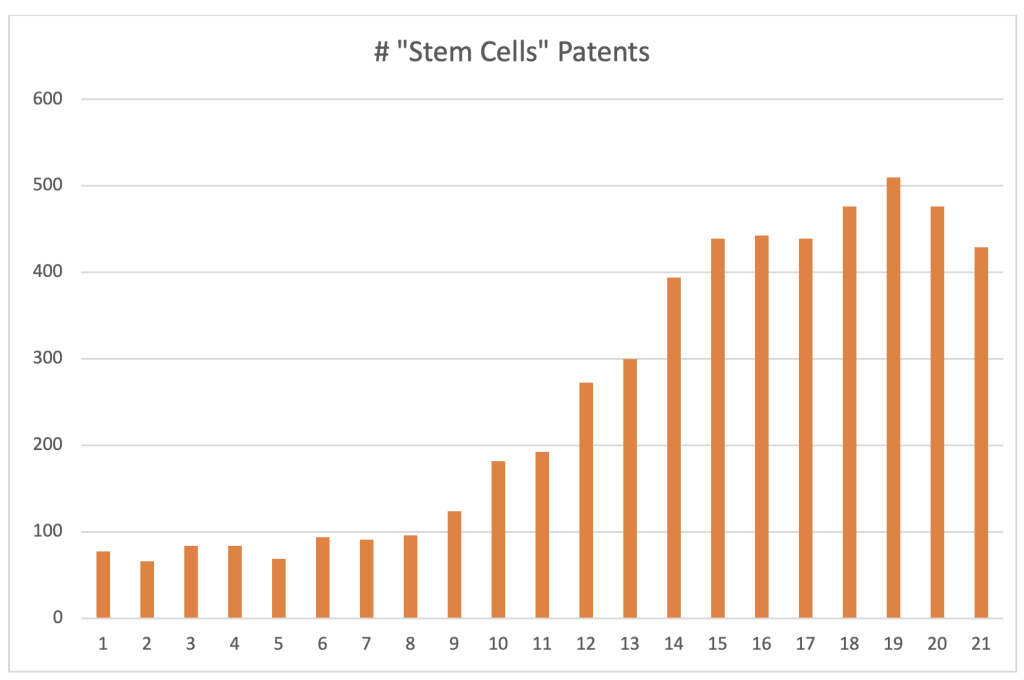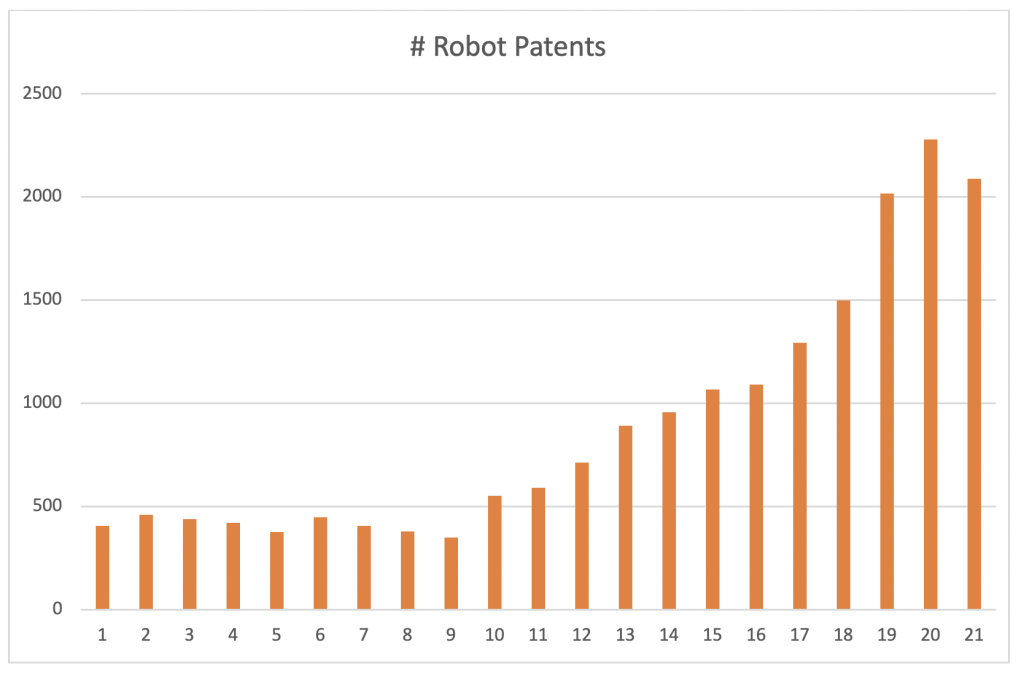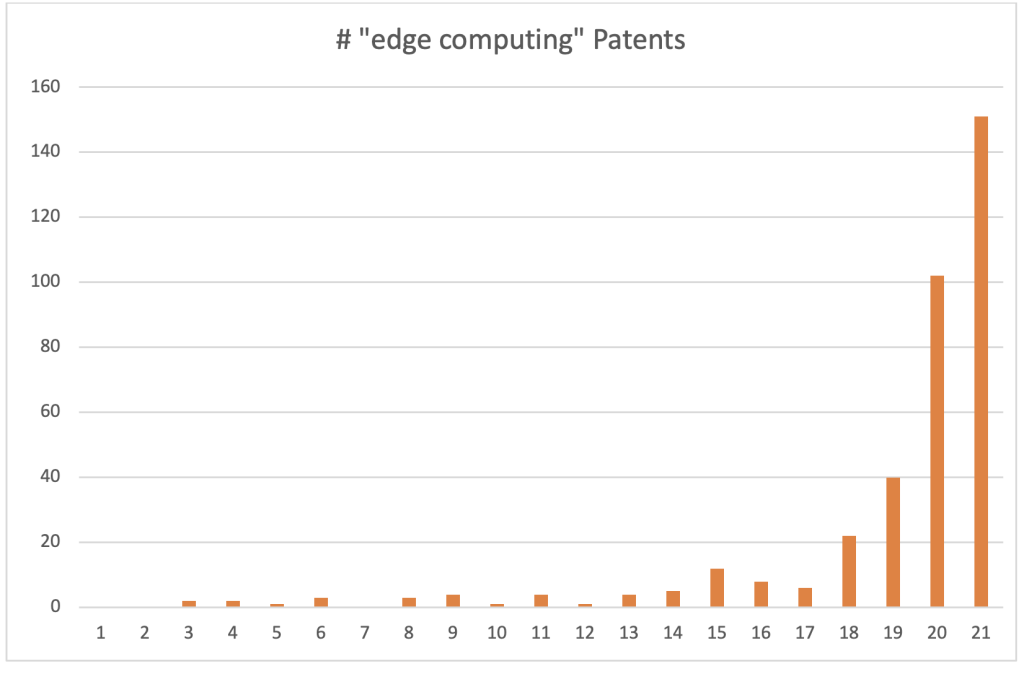 Previously, I’ve written about patent trends for the emerging technologies of deep learning, blockchain, and quantum computing.
Previously, I’ve written about patent trends for the emerging technologies of deep learning, blockchain, and quantum computing.
This article shifts the focus to the realms of biology (“stem cells”), machinery (“robot”), and then back to computing, and specifically to a topic suggested by a reader (with the handle “Primary Examiner”), “edge computing.” In each instance, the bar chart tells the same story.
Stem Cells
I’m going to quote two paragraphs from the National Institutes of Health’s article about stem cells, “Stem Cell Basics”:
“Stem cells have the remarkable potential to renew themselves. They can develop into many different cell types in the body during early life and growth. Researchers study many different types of stem cells. There are several main categories: the “pluripotent” stem cells (embryonic stem cells and induced pluripotent stem cells) and nonembryonic or somatic stem cells (commonly called “adult” stem cells). Pluripotent stem cells have the ability to differentiate into all of the cells of the adult body. Adult stem cells are found in a tissue or organ and can differentiate to yield the specialized cell types of that tissue or organ….
“Adult stem cells
Throughout the life of the organism, populations of adult stem cells serve as an internal repair system that generates replacements for cells that are lost through normal wear and tear, injury, or disease. Adult stem cells have been identified in many organs and tissues and are generally associated with specific anatomical locations. These stem cells may remain quiescent (non-dividing) for long periods of time until they are activated by a normal need for more cells to maintain and repair tissues.”
In fact, the term “stem cells” is also a fertile field for innovation and patents, and so is no stranger to the United States Patent and Trademark Office (USPTO).
As usual, I required the term “stem cells” to be in a patent’s claims when I searched the USPTO patent database. Sure enough, the resulting bar chart is reminiscent of an “emerging technology,” and will likely exceed 500 by the end of the year.

Robot
Regardless of my speculation that robots may have been envisioned first in science fiction stories, we now have the real thing, from robot vacuum cleaners to robot dogs.
In the bar chart below, note the y-axis. It starts at 500 and goes up to 2,500. (The bar chart for “stem cells” starts at only 100.). So, the base for “robot” was built over a long period of time, including all of the years before 2000.
However, in 2015, the number of patents with “robot” in the claims jumped from three digits to four, reaching 1,068 patents that year.
In 2018, the total for the year was 1,500 patents, and jumped in 2019 to over 2,000 patents. It stayed over 2,000 in 2020 and is already over 2,000, and as of December 7, 2021 has already reached 2,248.
There’s no doubt that there will be more robots. The applications are never-ending.

Edge Computing
To conclude, I’ll go back to “computing” in the form of “edge computing.” In this case, I’m responding to an IPWatchdog reader who called himself “Primary Examiner,” with my thanks.
So, first, what is “edge computing”?
Per Wikipedia, in a heavily footnoted entry, “One definition of edge computing is any type of computer program that delivers low latency nearer to the requests. Karim Arabi, in an IEEE DAC 2014 Keynote [7] and subsequently in an invited talk at MIT’s MTL Seminar in 2015, [8] defined edge computing broadly as all computing outside the cloud happening at the edge of the network, and more specifically in applications where real-time processing of data is required. In his definition, cloud computing operates on big data while edge computing operates on “instant data” that is real-time data generated by sensors or users.”
In another section of the Wikipedia entry, the examples are clarifying:
In a similar way, the aim of edge computing is to move the computation away from data centers towards the edge of the network, exploiting smart objects, mobile phones, or network gateways to perform tasks and provide services on behalf of the cloud.[16] By moving services to the edge, it is possible to provide content caching, service delivery, persistent data storage, and IoT [an abbreviation for the “Internet of Things”] management resulting in better response times and transfer rates. At the same time, distributing the logic to different network nodes introduces new issues and challenges.
Additional discussions are headlined as Privacy and Security; Scalability; Reliability; Speed; Efficiency; and Applications.
But is “edge computing” an emerging technology? The bar chart for patents that use “edge computing” in the claims provides the answer: “Yes,” definitely:

Image Source: Deposit Photos
Image ID:63109787
Copyright:Rawpixel

![[IPWatchdog Logo]](https://ipwatchdog.com/wp-content/themes/IPWatchdog%20-%202023/assets/images/temp/logo-small@2x.png)

![[Advertisement]](https://ipwatchdog.com/wp-content/uploads/2024/04/Patent-Litigation-Masters-2024-sidebar-early-bird-ends-Apr-21-last-chance-700x500-1.jpg)

![[Advertisement]](https://ipwatchdog.com/wp-content/uploads/2021/12/WEBINAR-336-x-280-px.png)
![[Advertisement]](https://ipwatchdog.com/wp-content/uploads/2021/12/2021-Patent-Practice-on-Demand-recorded-Feb-2021-336-x-280.jpg)
![[Advertisement]](https://ipwatchdog.com/wp-content/uploads/2021/12/Ad-4-The-Invent-Patent-System™.png)







Join the Discussion
16 comments so far.
Anon
December 15, 2021 10:30 amNick,
You again miss the point.
You want trendy language to be more than what it is, and insist on not seeing that the underlying tech often is addressed in multiple modes of language, some of which my be trendy, some may not.
You then fall to a fallacy of “well, if you could do better” as I have never stated that I could do so (you have attempted to move the argument to a position that I never staked out).
Then you double down on this logical fallacy with an insinuation that I may lack an ability to something that I never committed to doing, nor was ever a part of my position.
These responses only continue to lower your credibility.
You would be far better off merely conceding the point that I have presented.
Nick Brestoff
December 14, 2021 05:43 pmAnon,
“Patent trends” is accurately depicted in each of my articles. If you believe you have a better way of identifying “the more important trends of technology,” to quote you, you are free to write and submit an article of your own, should you have the ability to do so.
Anon
December 14, 2021 05:20 pmNick,
Choosing to be ‘satisfied’ with charting buzzwords is entirely a choice that you are free to make.
Just as such a choice necessarily lowers the credibility of your statements in regards to the more important trends of technology.
You do NOT get to choose the consequence of a p00r choice in sticking with ‘trendy language.’
Nick Brestoff
December 14, 2021 01:20 pmTo Burma Boy and Anon: If the chart for “edge computing” is correct, despite the debate about the “term” versus the “underlying meaning,” whatever that may be, I’m satisfied. If the bar chart sparks further inquiry into the underlying meaning of “edge computing” by curious minds, I’m satisfied.
Anon
December 14, 2021 09:01 amNick,
I am not the one that is confused and you are still missing the point.
You are “trending” a buzz word and attributing the trend to an underlying concept that covers more than just that buzz word. I have no doubt that the chart on the word is correct at the same time that your thinking what the chart dictates as to the concept is in clear error.
Nick Brestoff
December 13, 2021 08:57 pmReplying again to Anon. When I discussed the category of “edge computing” I quoted others who provided definitions of THAT term. As with any term that describes a category, the term carries with it more than one underlying meaning. Artificial Intelligence is broader than a neural network, which is broader than a deep neural network, which is broader than a multi-layer neural network. Alternatively, a specific term is distinct from another specific term in the same field, just as quantum computing is distinct from edge computing. If this contention does not clarify the matter, then I hope the examples to which I referred in my description of “edge computing” helped to clarify the “underlying meaning.” The data I obtained from the USPTO — and present in the bar charts — is for “edge computing” when that term is used by the inventor(s) in each patent’s claims.
Burma Boy
December 13, 2021 08:23 pmAnon, I apologize, it shows mine and my inability to use a phone correctly to see whole posts.
Burma Boy
December 13, 2021 08:22 pmNick,
The link shows that even in the name of the link, it considers routing within the scope of computing.
But it should be pointed out that the author literally used another link to claim the term means something different than its BRI, which isn’t true. But of course we live in a post truth world.
And Anon, you shouldn’t start a sentence claiming another’s logic is faulty, when all it does is show your limited range of thinking. Especially when your own post proves my literal point.
Anon
December 13, 2021 01:14 pmYou quite miss the point.
Use of a term and use of other terms (with the same meaning) only point out the trend of the term and NOT the trend of the underlying meaning.
Nick Brestoff
December 13, 2021 11:57 amTo Anon: I’ll defend. There’s an enormous difference between the frequency of “edge computing” as a term, for example, when used in a Detailed Description, and the use of the term in a patent’s claims. Intellectual Property borrows a term from “real property” and describes the claims as the “metes and bounds” of a patent; i.e., the scope of the patent. When the use of the term in the claims is small when used in the patents issued from 2003 to 2017 (less than ten each year with one exception in 2015) and then jumps up by “leaps and bounds” (as the bar chart shows) in 2018, 2019, 2020, and the first eleven months of 2021, it’s not unfair to describe “edge computing” as an “emerging technology.”
Nick Brestoff
December 13, 2021 11:46 amTo Burma Boy: Using the link you provided, “A router is a networking device that forwards data packets between computer networks.” Your link is off the mark. Also, the bar chart is clearly built based on an invention pertaining to “edge computing” in a patent’s claims. The likelihood that one or more inventors would receive a patent for “edge computing” in the claims when the inventor(s) meant that the scope of the patent was a “router” is near zero.
Anon
December 13, 2021 09:56 amI must disagree with the faulty logic of:
“But is “edge computing” an emerging technology? The bar chart for patents that use “edge computing” in the claims provides the answer: “Yes,” definitely”
The chart only shows the emerging use of the descriptive word. Simply put, the definition being used merely went by other words.
Burma Boy
December 12, 2021 01:46 amEdge routing isn’t computing? Computing is broader is it not?
https://en.m.wikipedia.org/wiki/Router_(computing)
Why do words appear to no longer mean the same when it is inconvenient to lawyers? i.e. vaccine, rioter.